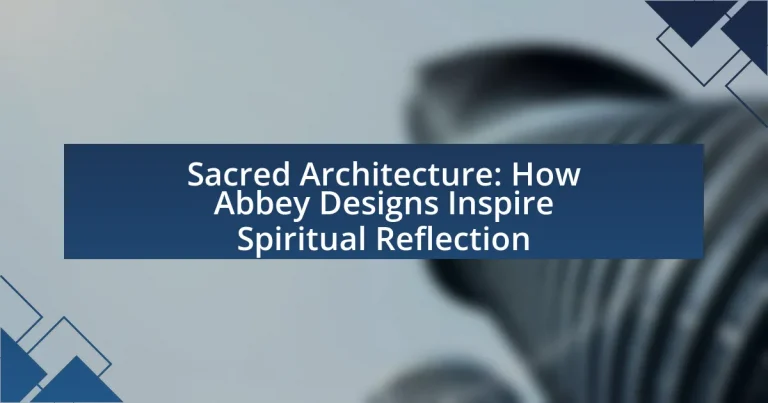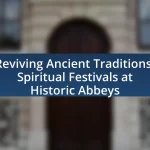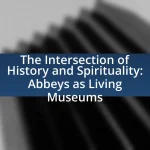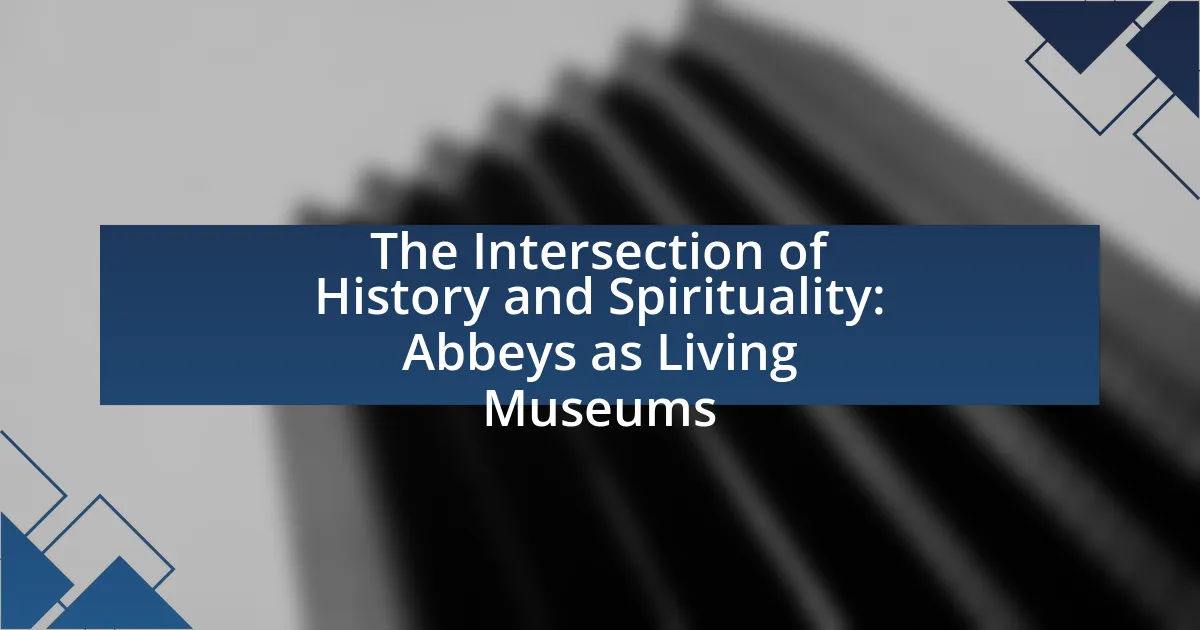Sacred architecture encompasses structures designed for religious or spiritual purposes, such as churches, temples, mosques, and synagogues, with a focus on fostering spiritual reflection and community gathering. This article explores the significance of sacred architecture, particularly abbeys, highlighting their unique characteristics, historical evolution, and the role they play in enhancing spiritual experiences through design elements like light, space, and symbolism. It also examines contemporary interpretations of abbey designs, the challenges faced by architects, and the importance of community input in creating spaces that resonate with spiritual needs.

What is Sacred Architecture and its Significance?
Sacred architecture refers to structures designed for religious or spiritual purposes, such as churches, temples, mosques, and synagogues. Its significance lies in its ability to create spaces that foster spiritual reflection, community gathering, and connection to the divine. Historical examples include the Gothic cathedrals of Europe, which were built to inspire awe and elevate the spirit, and the intricate designs of Hindu temples, which symbolize the cosmos and facilitate worship. These architectural forms often incorporate elements like light, space, and symbolism to enhance the spiritual experience, demonstrating how design can influence religious practice and community identity.
How does Sacred Architecture differ from other architectural styles?
Sacred architecture differs from other architectural styles primarily in its purpose and design, which are focused on spiritual reflection and worship. Unlike secular architecture, sacred architecture incorporates elements that evoke a sense of the divine, such as grand scale, intricate symbolism, and specific orientations towards sacred sites or celestial bodies. For example, many cathedrals are designed to direct attention upwards, using high ceilings and light to create an ethereal atmosphere, which is not typically a focus in secular buildings. Additionally, sacred architecture often employs specific materials and craftsmanship that reflect cultural and religious significance, such as the use of stained glass in churches to convey biblical stories. This intentional design serves to enhance the spiritual experience of the worshippers, setting it apart from other architectural styles that prioritize functionality or aesthetic appeal without a spiritual context.
What are the key characteristics of Sacred Architecture?
The key characteristics of Sacred Architecture include a sense of transcendence, the use of symbolic elements, and an emphasis on community and worship. Transcendence is often achieved through verticality and grand scale, as seen in cathedrals and temples designed to draw the eye upward, creating a connection to the divine. Symbolic elements, such as specific shapes, colors, and materials, convey spiritual meanings and reflect cultural beliefs, exemplified by the use of light in Gothic cathedrals to symbolize divine presence. Additionally, Sacred Architecture fosters community through spaces designed for gathering, such as naves and cloisters, which encourage collective worship and reflection, as demonstrated in the layout of abbeys and monasteries.
Why is Sacred Architecture important in cultural contexts?
Sacred architecture is important in cultural contexts because it serves as a physical manifestation of spiritual beliefs and communal identity. These structures, such as cathedrals, temples, and mosques, not only provide spaces for worship but also reflect the values, history, and artistic expressions of the cultures that create them. For instance, the Gothic cathedrals of Europe symbolize the medieval Christian worldview and community aspirations, while the intricate designs of Hindu temples illustrate the rich mythology and cosmology of Hinduism. Such architectural forms foster a sense of belonging and continuity within communities, reinforcing cultural heritage and spiritual practices.
What role do abbeys play in Sacred Architecture?
Abbeys serve as significant examples of Sacred Architecture by embodying spiritual ideals and facilitating communal worship. Their design often reflects a harmonious relationship between the built environment and the divine, with features such as cloisters, chapels, and altars that promote contemplation and prayer. Historically, abbeys were centers of monastic life, where architecture was intentionally crafted to inspire spiritual reflection, as seen in the use of light, space, and sacred geometry. For instance, the layout of the Abbey of Saint Gall, dating back to the 9th century, illustrates how architectural elements were meticulously planned to enhance the spiritual experience of the monks and visitors alike.
How have abbey designs evolved over time?
Abbey designs have evolved significantly over time, transitioning from simple monastic structures to complex architectural masterpieces. Initially, early abbeys, such as those built in the 4th and 5th centuries, featured basic layouts with minimal ornamentation, primarily focusing on functionality and the needs of monastic life. As the Romanesque period emerged in the 10th century, abbey designs incorporated thicker walls, rounded arches, and barrel vaults, reflecting a shift towards more robust and fortified structures.
The Gothic period, beginning in the 12th century, marked a dramatic transformation with the introduction of pointed arches, ribbed vaults, and flying buttresses, allowing for taller and more light-filled interiors. Notable examples include the Abbey of Saint-Denis, which showcased these innovations and influenced many subsequent designs. By the Renaissance, abbeys began to reflect classical influences, emphasizing symmetry and proportion, as seen in the Abbey of Mont-Saint-Michel.
In modern times, abbey designs have continued to adapt, incorporating contemporary materials and sustainable practices while maintaining their spiritual essence. This evolution illustrates how abbey architecture has responded to cultural, technological, and aesthetic changes throughout history, ultimately enhancing their role as spaces for spiritual reflection.
What are the most notable abbeys in history?
The most notable abbeys in history include Mont Saint-Michel in France, Westminster Abbey in England, and Cluny Abbey in France. Mont Saint-Michel, built in the 8th century, is renowned for its stunning architecture and strategic location on a rocky island, making it a UNESCO World Heritage site. Westminster Abbey, established in the 10th century, is famous for its Gothic architecture and as the site of royal ceremonies, including coronations and weddings. Cluny Abbey, founded in 910, was once the largest church in the world and a center of monastic reform, influencing the development of medieval architecture and monastic life across Europe. These abbeys exemplify significant historical, architectural, and cultural contributions, reinforcing their status as notable landmarks in history.

How do Abbey Designs Inspire Spiritual Reflection?
Abbey designs inspire spiritual reflection through their architectural elements that promote contemplation and connection to the divine. The use of expansive spaces, natural light, and harmonious proportions creates an atmosphere conducive to meditation and prayer. For instance, the layout of many abbeys often includes cloisters and chapels that encourage quiet introspection, allowing individuals to engage deeply with their spirituality. Historical evidence shows that the design principles of Gothic architecture, prevalent in abbeys, were intentionally crafted to elevate the spirit and direct attention toward the heavens, reinforcing the idea that the physical space can enhance spiritual experiences.
What architectural elements contribute to spiritual reflection in abbeys?
Architectural elements that contribute to spiritual reflection in abbeys include high vaulted ceilings, large stained glass windows, and cloisters. High vaulted ceilings create a sense of verticality and openness, encouraging contemplation and a connection to the divine. Large stained glass windows filter natural light into vibrant colors, symbolizing spiritual illumination and enhancing the atmosphere of reverence. Cloisters provide a tranquil outdoor space for meditation and reflection, often designed with serene gardens that promote peace and introspection. These elements collectively foster an environment conducive to spiritual reflection, as evidenced by the enduring use of abbeys for meditation and worship throughout history.
How do light and space influence the spiritual experience in abbeys?
Light and space significantly influence the spiritual experience in abbeys by creating an atmosphere conducive to contemplation and connection with the divine. The use of natural light, often filtered through stained glass windows, enhances the sacredness of the space, casting colorful patterns that evoke emotional responses and symbolize spiritual themes. For instance, the design of Gothic abbeys incorporates high ceilings and expansive nave spaces, which instill a sense of awe and transcendence, encouraging visitors to reflect on their spirituality. Historical studies, such as those by architectural historian John Ruskin, emphasize that the interplay of light and architectural space can elevate the human spirit, making the experience within abbeys profoundly impactful.
What symbolism is present in abbey architecture?
Abbey architecture symbolizes spiritual aspiration and divine connection through its design elements. The layout often reflects a cross shape, representing Christianity, while the use of light through stained glass windows signifies the presence of the divine. Additionally, the incorporation of cloisters and gardens symbolizes contemplation and the harmony between nature and spirituality. Historical examples, such as the Abbey of Saint-Germain-des-Prés in Paris, illustrate these symbolic elements, emphasizing the role of architecture in fostering a sacred atmosphere conducive to reflection and worship.
Why is the layout of an abbey significant for spiritual practices?
The layout of an abbey is significant for spiritual practices because it is intentionally designed to facilitate contemplation, community, and connection with the divine. The arrangement of spaces, such as the church, cloisters, and gardens, promotes a sense of order and tranquility, which are essential for meditation and prayer. For instance, the orientation of the church towards the east symbolizes the resurrection and the coming of light, enhancing the spiritual experience during worship. Additionally, the separation of communal areas from private spaces allows for both collective worship and individual reflection, catering to diverse spiritual needs. Historical examples, such as the layout of the Abbey of Cluny, demonstrate how architectural design directly influences the monastic life and spiritual practices of its inhabitants.
How does the orientation of an abbey affect its spiritual ambiance?
The orientation of an abbey significantly influences its spiritual ambiance by aligning the structure with celestial and natural elements, which enhances the sense of transcendence. For instance, many abbeys are oriented towards the east, allowing the rising sun to illuminate the altar during morning services, symbolizing resurrection and enlightenment. This alignment not only creates a visually striking experience but also fosters a deeper spiritual connection for worshippers, as evidenced by historical practices in Christian architecture where eastward orientation is a common tradition. Such design choices reflect a deliberate intention to harmonize the physical space with spiritual beliefs, thereby enriching the overall atmosphere of contemplation and devotion within the abbey.
What are the common spatial arrangements found in abbeys?
Common spatial arrangements found in abbeys include a central church, cloisters, and various functional buildings such as dormitories and refectories. The central church typically serves as the focal point for worship and is often oriented eastward, reflecting traditional Christian practices. Cloisters, which are covered walkways surrounding a courtyard, provide a space for meditation and community interaction. Additionally, dormitories accommodate monks or nuns, while refectories serve as dining areas, emphasizing communal living. These arrangements are designed to facilitate both spiritual reflection and communal life, as seen in historical examples like the Abbey of Cluny in France, which showcases these elements in its layout.

What are the Contemporary Interpretations of Abbey Designs?
Contemporary interpretations of abbey designs emphasize minimalism, sustainability, and community engagement. Modern architects often draw inspiration from traditional abbey structures, incorporating elements such as open spaces and natural materials to create environments conducive to reflection and spirituality. For instance, the use of large windows in contemporary abbeys allows for natural light to enhance the spiritual atmosphere, mirroring the historical emphasis on divine illumination. Additionally, many new designs prioritize eco-friendly practices, reflecting a growing awareness of environmental stewardship within spiritual contexts. This shift aligns with the historical role of abbeys as centers of learning and community, adapting to contemporary needs while maintaining their sacred essence.
How are modern architects incorporating traditional abbey elements?
Modern architects are incorporating traditional abbey elements by integrating features such as vaulted ceilings, cloisters, and stained glass windows into contemporary designs. These architectural elements evoke a sense of spirituality and tranquility, reminiscent of historical abbeys. For instance, the use of large, arched windows allows natural light to flood the interior, creating an atmosphere similar to that found in traditional abbeys, which often emphasized light as a symbol of divinity. Additionally, modern designs frequently include open courtyards or gardens, reflecting the abbey’s connection to nature and contemplation. This approach not only preserves the aesthetic and spiritual significance of abbey architecture but also adapts it to meet the needs of modern communities, fostering spaces for reflection and gathering.
What are some examples of contemporary sacred spaces inspired by abbeys?
Contemporary sacred spaces inspired by abbeys include the Benedictine Abbey of Our Lady of the Holy Spirit in Georgia, which reflects traditional monastic architecture while serving modern spiritual needs. Another example is the Taizé Community in France, known for its simple, communal worship spaces that draw on the principles of abbey design to foster contemplation and community. Additionally, the Abbey of Gethsemani in Kentucky, founded by Thomas Merton, combines traditional abbey elements with contemporary practices, emphasizing silence and solitude for spiritual growth. These spaces illustrate how modern architecture can maintain the essence of abbey design while adapting to contemporary spiritual practices.
How do these modern designs maintain spiritual significance?
Modern designs maintain spiritual significance by integrating traditional architectural elements with contemporary aesthetics, creating spaces that foster reflection and connection to the divine. For instance, many modern abbeys utilize natural materials and open layouts that invite light, symbolizing enlightenment and spiritual awakening. This approach aligns with historical practices where architecture served as a physical manifestation of spiritual beliefs, such as the use of vaulted ceilings to evoke a sense of reaching towards the heavens. Additionally, the incorporation of sacred geometry in modern designs echoes ancient principles, reinforcing the idea that space can influence spiritual experience.
What challenges do architects face when designing sacred spaces today?
Architects face several challenges when designing sacred spaces today, including balancing modern functionality with traditional spiritual requirements. The integration of contemporary materials and technologies often conflicts with the historical and cultural significance of sacred architecture, which demands a deep understanding of the site’s religious context. Additionally, architects must navigate diverse community expectations and beliefs, ensuring that the design resonates with various congregational needs while maintaining a sense of reverence. Furthermore, sustainability concerns are increasingly important, as architects strive to create environmentally friendly spaces that still honor the sacred purpose. These challenges highlight the complexity of designing spaces that are both functional and spiritually uplifting in a rapidly changing world.
How can architects balance tradition and innovation in sacred architecture?
Architects can balance tradition and innovation in sacred architecture by integrating historical design elements with contemporary materials and technologies. This approach allows for the preservation of cultural and spiritual significance while addressing modern needs and aesthetics. For instance, the use of traditional forms, such as vaulted ceilings or stained glass, can be combined with sustainable building practices and innovative structural techniques, as seen in the design of the Chapel of St. Ignatius in Seattle, which incorporates modern materials while respecting the spiritual context. This method not only honors the past but also creates spaces that resonate with current and future generations, ensuring that sacred architecture remains relevant and meaningful.
What role does community input play in the design of modern abbeys?
Community input is essential in the design of modern abbeys, as it ensures that the structures reflect the values and needs of the local population. Engaging community members in the design process fosters a sense of ownership and belonging, which is crucial for the spiritual and social functions of the abbey. For instance, architects often conduct workshops and surveys to gather feedback on design elements, ensuring that the final structure resonates with the community’s cultural and spiritual identity. This collaborative approach not only enhances the aesthetic and functional aspects of the abbey but also strengthens community ties, making the space a true reflection of collective aspirations and beliefs.
What practical tips can enhance the spiritual experience in abbey-inspired spaces?
To enhance the spiritual experience in abbey-inspired spaces, individuals should engage in mindful practices such as meditation, prayer, and quiet reflection. These activities allow for deeper connection with the serene environment typically found in abbeys, which are designed to promote contemplation and tranquility. The architectural elements, such as high ceilings and natural light, contribute to a sense of awe and peace, making them ideal for spiritual activities. Historical evidence shows that abbeys have been used for centuries as places of spiritual retreat, emphasizing their role in fostering a reflective atmosphere.





